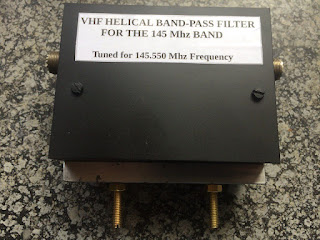All credit for this project must go to Mile Kokotov Z33T. I constructed this filter from his original article, video and images. I take no credit for any information related to this project other than my test results which I will publish in a future post.
This home made low loss helical bandpass filter for 145 MHz is tunable from 110 MHz to 160 MHz. Bandpass filters are useful for the RTL-SDR as often strong out of band signals can cause overload, causing poor reception. I constructed this filter to use with my RTL-SDR.
A bandpass filter blocks all signals outside of its pass band. A helical bandpass filter is simply a coiled wire enclosed in a conductive container that can be tuned with a variable capacitor made out of two plates.
Mile writes:
Basic design of the filter is from RSGB VHF-UHF Manual, but I made some modifications. (Click below on "Show More" for more info) Both Inductors (coils) are made from 6 mm2 copper wire (the wire diameter is 2.6 mm). Coils has 6 turns. Coils diameter is 23 mm Coils Length is 35 mm The tuning capacitors are made from two copper or stainless steel round plates, about 31 to 32 mm in diameter each. (about 760 mm2) One must be very careful using other variable capacitors instead of my suggestions here. There is very high RF voltage on this capacitors. When I was making experiments by using two pieces of RG-58 coaxial cable 16 mm each, as a capacitors (which is about 1.6 pf), and when I applied about 8 watts RF power on 145 MHz, the coaxial cable pieces burned immediately. You can imagine how high RF voltage is present here, because maximum voltage by producer specification for RG-58 coaxial cable is more then 1,4 kV RF Voltage. This Helical Bandpass filter has very low loss. About minus 0.3 dB for the 5 MHz bandwidth and minus 3 dB for 8 MHz bandwidth.
You can use it for improving the receiver front-end by reject out-of-band unwanted strong signals which can make interference and block your receiver, making incapable to receive weak signal of interest.
This filter can also be very useful for rejecting unwanted harmonics signals from your transmitter, making your neighbors happier…
When I connect this filter to my Baofeng UV-5R handheld transceiver, it has improve receiver ability for weak signals in 2 m band dramatically!!! Almost all wide frequency range transceivers suffers from low dynamic range in the receiver front-end. That is because it is almost impossible to made a good RF tracking filter in the front end of the receiver, for reasonable price. Using this bandpass filter for those transceivers/receivers make huge improvement for receiving weak signals, especially in urban area with many strong RF signals.
The signal loss is only 0.3 dB. In other words, when I tested this filter on 145 MHz, and applied 10W RF power from my transmitter through filter to dipole antenna, the signal loss was only 0.7 W. It means that 9.3 W goes to antenna. (7% signal loss). On the receiving mode I can not noticed any signal changes with or without this filter even with the very weak signals, almost buried in the noise.
More info: HERE
You can see measuring and characterization of this filter: HERE
The images below is my version of this band-pass filter. I will be testing this filter extensively over a period and will provide my finding in a follow up article: (Click on images for larger view.)

















